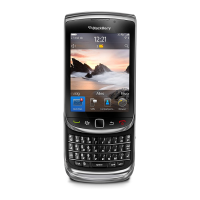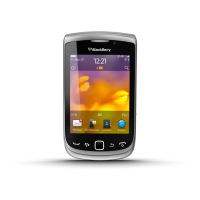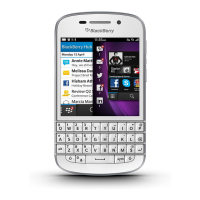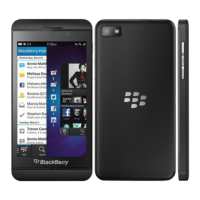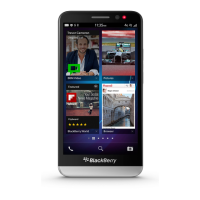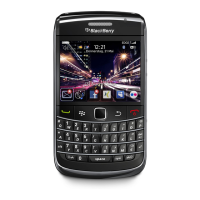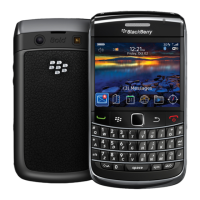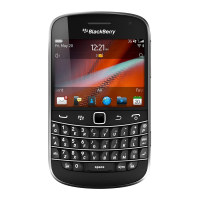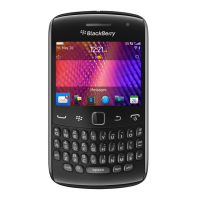Do you have a question about the Blackberry TOUR 9630 and is the answer not in the manual?
Shortcuts for making calls, managing call features, and speakerphone.
Keyboard shortcuts for managing messages and attachments.
Keyboard shortcuts for navigating and using the web browser.
Keyboard shortcuts for text input and editing.
Fundamental operations for making and managing phone calls.
Procedures for making emergency calls and understanding callback mode.
Managing voice messages, checking voicemail, and setting access numbers.
Using voice commands for making calls and checking device status.
How to make and manage conference calls.
Setting up and managing call forwarding options.
Managing and switching between multiple phone numbers.
Customizing call settings, dialing behavior, and display.
Resolving common issues with making, receiving, or displaying calls.
Core functions for composing, sending, and managing messages.
Sending, receiving, and managing email communications.
Sending and managing BlackBerry PIN messages.
Sending and receiving SMS text messages.
Sending and managing multimedia messages.
Securing email and PIN messages using S/MIME.
Securing email and PIN messages using PGP encryption.
Resolving common issues with sending and receiving messages.
Viewing and handling various file attachments.
Handling and viewing media files like images and videos.
Resolving issues with attachments not appearing or truncating.
Steps for capturing still images using the device camera.
Instructions for capturing video clips with the device.
Configuring settings for picture and video quality.
Resolving issues with camera and video features.
Moving media files between device and computer.
Playing audio/video and recording voice memos.
Organizing and manipulating media content like playlists and files.
Displaying and interacting with image files.
Managing media cards and mass storage connections.
Resolving issues with media playback and storage.
Navigating the web and using browser features.
Adding, managing, and using bookmarks for web pages.
Customizing browser display, JavaScript, and security settings.
Configuring security settings like TLS, SSL, and WTLS.
Resolving issues with browser functionality and web page loading.
Setting and managing alarms.
Resolving issues with date, time, and alarm settings.
Resolving issues with contact data display and synchronization.
Resolving issues with text input and spell check.
Resolving issues with character display and language settings.
Searching for content within messages and web pages.
Syncing email messages wirelessly.
Syncing contacts, calendar, tasks, and memos.
Procedures for backing up and restoring device data.
Wiping all data from the device.
Connecting the device to other Bluetooth devices.
Resolving issues with Bluetooth connections and pairing.
Resolving issues with GPS functionality.
Resolving map display and connectivity issues.
Adding, managing, and responding to BBM contacts.
Resolving issues with network connectivity.
Protecting the SIM card with a PIN code.
Setting up a PIN to secure the SIM card.
Overview of device passwords and keyboard locking.
Establishing a password for device access.
Modifying the existing device password.
Storing and managing passwords securely.
Protecting device data through file encryption.
Enabling content protection for stored data.
Managing digital certificates for secure communication.
Managing PGP keys for encrypted communications.
Accessing and managing stored certificates and keys.
Using smart cards for authentication and security.
Resolving issues related to device and application security.
Running and submitting diagnostic reports for troubleshooting.
Shortcuts for making calls, managing call features, and speakerphone.
Keyboard shortcuts for managing messages and attachments.
Keyboard shortcuts for navigating and using the web browser.
Keyboard shortcuts for text input and editing.
Fundamental operations for making and managing phone calls.
Procedures for making emergency calls and understanding callback mode.
Managing voice messages, checking voicemail, and setting access numbers.
Using voice commands for making calls and checking device status.
How to make and manage conference calls.
Setting up and managing call forwarding options.
Managing and switching between multiple phone numbers.
Customizing call settings, dialing behavior, and display.
Resolving common issues with making, receiving, or displaying calls.
Core functions for composing, sending, and managing messages.
Sending, receiving, and managing email communications.
Sending and managing BlackBerry PIN messages.
Sending and receiving SMS text messages.
Sending and managing multimedia messages.
Securing email and PIN messages using S/MIME.
Securing email and PIN messages using PGP encryption.
Resolving common issues with sending and receiving messages.
Viewing and handling various file attachments.
Handling and viewing media files like images and videos.
Resolving issues with attachments not appearing or truncating.
Steps for capturing still images using the device camera.
Instructions for capturing video clips with the device.
Configuring settings for picture and video quality.
Resolving issues with camera and video features.
Moving media files between device and computer.
Playing audio/video and recording voice memos.
Organizing and manipulating media content like playlists and files.
Displaying and interacting with image files.
Managing media cards and mass storage connections.
Resolving issues with media playback and storage.
Navigating the web and using browser features.
Adding, managing, and using bookmarks for web pages.
Customizing browser display, JavaScript, and security settings.
Configuring security settings like TLS, SSL, and WTLS.
Resolving issues with browser functionality and web page loading.
Setting and managing alarms.
Resolving issues with date, time, and alarm settings.
Resolving issues with contact data display and synchronization.
Resolving issues with text input and spell check.
Resolving issues with character display and language settings.
Searching for content within messages and web pages.
Syncing email messages wirelessly.
Syncing contacts, calendar, tasks, and memos.
Procedures for backing up and restoring device data.
Wiping all data from the device.
Connecting the device to other Bluetooth devices.
Resolving issues with Bluetooth connections and pairing.
Resolving issues with GPS functionality.
Resolving map display and connectivity issues.
Adding, managing, and responding to BBM contacts.
Resolving issues with network connectivity.
Protecting the SIM card with a PIN code.
Setting up a PIN to secure the SIM card.
Overview of device passwords and keyboard locking.
Establishing a password for device access.
Modifying the existing device password.
Storing and managing passwords securely.
Protecting device data through file encryption.
Enabling content protection for stored data.
Managing digital certificates for secure communication.
Managing PGP keys for encrypted communications.
Accessing and managing stored certificates and keys.
Using smart cards for authentication and security.
Resolving issues related to device and application security.
Running and submitting diagnostic reports for troubleshooting.
| Panel type | TFT |
|---|---|
| Display diagonal | 2.4 \ |
| Display resolution | 480 x 360 pixels |
| Display number of colors | 65536 colors |
| Ringer type | Polyphonic |
| Processor frequency | 0.528 GHz |
| Internal memory | 256 MB |
| Compatible memory cards | microSDHC |
| Sensor type | CMOS |
| Digital zoom | 2 x |
| Rear camera resolution | 2048 x 1536 pixels |
| Headphone connectivity | 3.5 mm |
| USB 2.0 ports quantity | 1 |
| Audio formats supported | AAC, AAC+, eAAC+, MP3, WMA |
| Platform | BlackBerry |
| Operating system installed | BlackBerry OS |
| Talk time (2G) | 5 h |
| Battery capacity | 1400 mAh |
| Standby time (2G) | 336 h |
| Form factor | Bar |
| Keyboard layout | QWERTY |
| 2G standards | EDGE, GPRS |
| Data network | 3G |
| Bluetooth version | 2.0+EDR |
| Depth | 14.2 mm |
|---|---|
| Width | 62 mm |
| Height | 112 mm |
| Weight | 130 g |
